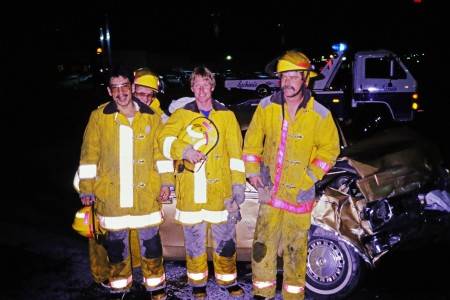ALTERED MENTAL STATUS
ALL LEVELS
DESIGNATION OF CONDITION
Signs and symptoms may include any or all of the following: limited or no response to verbal or painful stimuli, inappropriate responses, irrational behavior and unable to ascertain causation.
EMPHASIS ON PATIENT CARE
Airway management, adequate perfusion
1. Primary Management - Assess ABC’s and manage as indicated. If occult trauma is possible, consider spinal restriction.
2. Secondary Management - History, physical exam, Vital Signs
3. Perform glucometry
a. If the glucose is < 60 mg/deciliter and associated signs and symptoms of hypoglycemia, follow Diabetic Emergencies Treatment Guidelines.
b. If the glucose is > 60 mg/deciliter and narcotic overdose suspected, follow:
Poisoning/ Overdose Treatment Guidelines.
4. If narcotic overdose or hypoglycemia is not suspected, transport the patient without delay to an appropriate medical facility.
5. If no AEMT/ALS capability, radio for AEMT or ALS intercept.
6. If patient exhibits signs and symptoms of shock, follow Shock Treatment Guidelines.
7. Transport with head elevated 30-45 degrees
8. Evaluate AMS using Cincinnati Pre-hospital Stroke Scale (CPSS)
9. NALOXONE 0.4 mg IV/IM/IO/IN for suspected narcotic overdose with respiratory depression, may repeat x5. Consider possible causes of AMS:
A- Alcohol / Acidosis
E- Endocrine / Epilepsy / Electrolytes / Encephalopathy I– Infection
O– Opiates / Overdose U– Uremia
T– Trauma I– Insulin
P– Poisoning / Psychosis S– Stroke
AEMT / PARAMEDIC
8. Initiate IV access; if necessary, titrate isotonic solution to end organ perfusion
9. Consider IO access if patient condition warrants and peripheral IV site is unobtainable.
Note: Dextrose administration may be harmful for patients with ischemic brain injury. However, dextrose should never be withheld in any patient suspected of hypoglycemia. When in doubt, treat for hypoglycemia if unable to perform glucometry.
• Titrate use of Naloxone in patients with respiratory depression to avoid transition to combative behavior by patient.
• Use appropriate discretion regarding immediate intubation of patients who may quickly regain consciousness, such as hypoglycemic after administration of dextrose or opiate overdoes cases after administration of Naloxone.
CINCINNATI PREHOSPITAL STROKE SCALE (CPSS)
Facial Droop
Normal: Both sides of face move equally
Abnormal: One side of face does not move at all
Arm Drift
Normal: Both arms move equally or not at all
Abnormal: One arm drifts compared to the other
Speech
Normal: Patient uses correct words with no slurring
Abnormal: Slurred or inappropriate words or mute
Interpretation: If any 1 of these 3 signs is abnormal, the probability of a stroke is 72%.
ALL LEVELS
DESIGNATION OF CONDITION
Signs and symptoms may include any or all of the following: limited or no response to verbal or painful stimuli, inappropriate responses, irrational behavior and unable to ascertain causation.
EMPHASIS ON PATIENT CARE
Airway management, adequate perfusion
1. Primary Management - Assess ABC’s and manage as indicated. If occult trauma is possible, consider spinal restriction.
2. Secondary Management - History, physical exam, Vital Signs
3. Perform glucometry
a. If the glucose is < 60 mg/deciliter and associated signs and symptoms of hypoglycemia, follow Diabetic Emergencies Treatment Guidelines.
b. If the glucose is > 60 mg/deciliter and narcotic overdose suspected, follow:
Poisoning/ Overdose Treatment Guidelines.
4. If narcotic overdose or hypoglycemia is not suspected, transport the patient without delay to an appropriate medical facility.
5. If no AEMT/ALS capability, radio for AEMT or ALS intercept.
6. If patient exhibits signs and symptoms of shock, follow Shock Treatment Guidelines.
7. Transport with head elevated 30-45 degrees
8. Evaluate AMS using Cincinnati Pre-hospital Stroke Scale (CPSS)
9. NALOXONE 0.4 mg IV/IM/IO/IN for suspected narcotic overdose with respiratory depression, may repeat x5. Consider possible causes of AMS:
A- Alcohol / Acidosis
E- Endocrine / Epilepsy / Electrolytes / Encephalopathy I– Infection
O– Opiates / Overdose U– Uremia
T– Trauma I– Insulin
P– Poisoning / Psychosis S– Stroke
AEMT / PARAMEDIC
8. Initiate IV access; if necessary, titrate isotonic solution to end organ perfusion
9. Consider IO access if patient condition warrants and peripheral IV site is unobtainable.
Note: Dextrose administration may be harmful for patients with ischemic brain injury. However, dextrose should never be withheld in any patient suspected of hypoglycemia. When in doubt, treat for hypoglycemia if unable to perform glucometry.
• Titrate use of Naloxone in patients with respiratory depression to avoid transition to combative behavior by patient.
• Use appropriate discretion regarding immediate intubation of patients who may quickly regain consciousness, such as hypoglycemic after administration of dextrose or opiate overdoes cases after administration of Naloxone.
CINCINNATI PREHOSPITAL STROKE SCALE (CPSS)
Facial Droop
Normal: Both sides of face move equally
Abnormal: One side of face does not move at all
Arm Drift
Normal: Both arms move equally or not at all
Abnormal: One arm drifts compared to the other
Speech
Normal: Patient uses correct words with no slurring
Abnormal: Slurred or inappropriate words or mute
Interpretation: If any 1 of these 3 signs is abnormal, the probability of a stroke is 72%.
